Chair, Department of Orthopedic Surgery
University of Minnesota Medical School
Minneapolis, Minnesota
Position Overview
The University of Minnesota Medical School invites applications for the role of Chair of the Department of Orthopedic Surgery. This prestigious position presents a unique opportunity for an accomplished leader to shape the future of orthopedic surgery within one of the nation’s top academic health systems. As a key leader in the Medical School and Health Systems, the successful Chair will play a strategically important role in advancing the institution’s mission of delivering world-class care, driving innovation, and fostering interdisciplinary collaboration to address the most complex musculoskeletal challenges.
Role & Responsibilities
The ideal candidate will possess a compelling vision for the future of orthopedic surgery and the expertise to translate that vision into actionable strategies that elevate the department. As Chair, you will play a pivotal role:
- Strategic Leadership: Develop and implement a forward-thinking strategic plan that enhances the department’s clinical, research, and educational programs while aligning with the broader goals of the University of Minnesota Medical School and M Health Fairview.
- Faculty Development: Recruit, mentor, and retain top-tier faculty and staff, fostering a culture of collaboration, inclusion, and professional growth.
- Research Advancement: Oversee a robust and diverse research portfolio, promoting interdisciplinary collaboration and securing extramural funding to advance the field of orthopedic surgery.
- Clinical Excellence: Expand and innovate clinical programs to provide cutting-edge, patient-centered care across all subspecialties, including joint replacement, sports medicine, trauma, and pediatric orthopedics.
- Education and Training: Strengthen residency and fellowship programs, support innovative methodologies, and prepare the next generation of orthopedic surgeons and leaders. Expand robust medical student training program across two regional campus locations.
- Financial and Operational Management: Effectively manage departmental resources, including budget oversight, philanthropic development, and resource allocation to achieve strategic goals.
- External Engagement: Build and maintain strong relationships with regional and national healthcare leaders, industry partners, and community stakeholders to enhance the department’s reputation and influence.
Required Qualifications
- Educational and Professional Credentials:
- MD or DO degree with board certification in Orthopedic Surgery.
- Eligible for medical licensure in Minnesota.
- Qualified for appointment at the rank of Professor in the University of Minnesota Medical School.
- Leadership Experience:
- At least 10 years of progressive leadership experience in an academic medical setting, with a demonstrated ability to achieve departmental goals and initiatives.
- Experience navigating and cultivating relationships within complex health systems and engaging key community partners to advance shared goals.
- Proven ability to lead multidisciplinary teams and inspire excellence in education, research, and clinical care.
- Academic Excellence:
- Nationally or internationally recognized expertise in orthopedic surgery, evidenced by a distinguished record of scholarly contributions, including high-impact publications.
- Success in securing competitive research funding (e.g., NIH, foundations, industry).
- Skills and Competencies:
- Exceptional leadership, interpersonal, and communication skills, with the ability to engage diverse audiences, including faculty, staff, students, patients, donors, and external stakeholders.
- Strong fiscal management skills, with experience overseeing complex budgets and allocating resources effectively.
- Mentorship and Faculty Development:
- Commitment to mentoring and developing faculty and trainees, fostering academic and professional growth.
- Clinical Excellence and Innovation:
- Proven ability to expand and enhance clinical programs, ensuring patient safety, quality of care, and improved access to services.
- Commitment to Diversity, Equity, and Inclusion:
- A strong dedication to advancing diversity, equity, and inclusion across the department’s mission.
Why Join Us?
The University of Minnesota Medical School is a world-class institution dedicated to advancing medical discovery, education, and patient care. It is part of the University of Minnesota Twin Cities, the flagship campus of the UMN System and the state’s only land-grant university, one of the nation’s most prestigious public research institutions. Recognized as a Public Ivy, the university is also one of the few in the nation to house schools of medicine, nursing, engineering, law, veterinary medicine, and agriculture all on a single campus, fostering unparalleled interdisciplinary collaboration.
As Chair of the Department of Orthopedic Surgery, you will lead a dynamic team of renowned experts, leveraging the department’s long-standing legacy of innovation to shape the future of musculoskeletal health.
This role offers the opportunity to collaborate with some of the nation’s leading healthcare organizations, including M Health Fairview, TRIA Orthopedic , CentraCare, HealthPartners, Regions Hospital, Hennepin Healthcare, and Gillette Children’s Specialty Hospital. The department is poised for transformative growth under visionary leadership, with unparalleled resources to expand its clinical programs, research portfolio, and educational excellence.
Located in the vibrant Twin Cities of Minneapolis and St. Paul, this role offers a unique leadership platform at a top-tier academic medical center while enjoying an exceptional quality of life, cultural richness, and economic strength. Join us in advancing orthopedic surgery and musculoskeletal health, making a lasting impact on patients and the field.
Department of Orthopedic Surgery

The University of Minnesota Department of Orthopedic Surgery stands as a nationally recognized leader in advancing musculoskeletal health, with a distinguished 75- legacy of excellence in patient care, research, and education. The department has grown to encompass over 95 faculty members, including nationally and internationally recognized experts across all orthopedic subspecialties, making it one of the largest and most comprehensive orthopedic surgery departments in the nation. It fosters an inclusive and equitable environment, embracing the contributions of diverse faculty, trainees, staff, and patients to achieve excellence in all areas.

Key Features
- Faculty: Over 95 faculty members, including nationally and internationally recognized experts across various orthopedic subspecialties.
- Residents: 40 residents enrolled in a highly competitive, comprehensive training program.
- Fellowship Programs: Fellowship programs in Adult Reconstruction, Orthopedic Spine, Trauma, Combined Adult Reconstruction/Trauma, and Sports Medicine. Of which 3 are accredited and participation as a clinical site for the MN Hand and Upper Extremity Fellowsh
- Subspecialties: Expertise across multiple subspecialties, including Adult Reconstruction, Spine, Hand and Upper Extremity, Sports Medicine, Pediatric Orthopedics, Trauma, and Musculoskeletal Tumors.
- Clinical Partner Sites: Care provided at premier facilities, including M Health Fairview locations, TRIA Orthopedic Center, Regions Hospital, Gillette Children’s Specialty Healthcare, and CentraCare in St. Cloud.
- Research Excellence: Robust research programs supported by significant extramural funding, focusing on clinical outcomes, regenerative medicine, biomechanics, and innovative imaging techniques.
- Comprehensive Education: Diverse educational opportunities, including clerkship rotations at six unique clinical sites, residency training, and advanced simulation-based learning.
- Patient Care Reach: Serving thousands of patients annually with state-of-the-art treatments and technologies.
Education Programs
The Department offers exceptional programs for medical students, residents, fellows, and practitioners interested in lifelong learning.
Residency Program
The residency program at the University of Minnesota Department of Orthopedic Surgery provides a comprehensive educational experience for physicians pursuing accreditation as orthopedic surgeons. With a strong tradition of prioritizing education, innovation, and patient care, the program stands out for its unwavering commitment to resident training and the expertise of its faculty.
Residents train across six premier medical centers in the Twin Cities, offering unparalleled exposure to diverse patient populations and conditions. With eight positions available per class, the program provides hands-on experience in top-tier facilities, including:
- Regions Hospital: Level I trauma center in St. Paul, renowned for expertise in traumatology.
- Hennepin County Medical Center: Level 1 trauma center in the heart of downtown Minneapolis
- Gillette Children’s Specialty Healthcare: A leading center for pediatric orthopedic care and disabilities.
- Minneapolis VA Medical Center: The nation’s top VA facility for joint arthroplasty volume.
- University of Minnesota Medical Center: A flagship institution with over 20 subspecialists caring for complex cases.
- TRIA Orthopedic Center: A state-of-the-art facility offering advanced sports medicine training, including care for recreational, collegiate, and professional athletes.
- CentraCare MPhysicians (St. Cloud): Regional medical center providing specialty orthopedic care in sports medicine, arthroplasty, and trauma.
This diverse training environment ensures residents gain the skills and knowledge needed to excel in orthopedic surgery, guided by national leaders in the field.
Fellowship Programs
The department is an academic sponsor or clinical partner site for 6fellowship programs in the following subspecialties:
- Adult Reconstructive Surgery: The Adult Reconstructive Surgery Fellowship at the University of Minnesota Medical Center is a one-year, ACGME-accredited clinical fellowship sponsored by the University of Minnesota Department of Orthopedic Surgery
- Orthopedic Spine: The spine fellowship is sponsored by the University of Minnesota and trains fellows in the management of complex pediatric and adult spine pathology. Clinical education takes place at the University of Minnesota Medical Center (UMMC).
- Regions Orthopedic Trauma: The Regions Hospital/University of Minnesota Orthopedic Trauma fellowship at Regions hospital is a one-year, OTA accredited clinical fellowship that is sponsored by the University of Minnesota Department of Orthopedic Surgery.
- Combined Adult Reconstruction/Trauma (CAR/T): The Regions Hospital/University of Minnesota Combined Adult Reconstruction/Trauma Fellowship Program is a 12-month unique training experience in the operative and clinical management of adult reconstruction combined with orthopedic trauma.
- Minnesota Hand Surgery: The Minnesota Hand Surgery Fellowship, sponsored by the HealthPartners Institute for Medical Education at Regions Hospital, is a one-year, ACGME-accredited program. The University of Minnesota Department of Orthopedic Surgery is a participating site.
- Sports Medicine & Shoulder: The Sports Medicine fellowship at TRIA Orthopedic Center is a one-year, ACGME-accredited clinical fellowship that is sponsored by the University of Minnesota Department of Orthopedic Surgery.
Medical Student Clerkship Program
The Department of Orthopedic Surgery offers diverse clerkship rotations at six Twin Cities sites, exposing medical students to a broad spectrum of orthopedic conditions and patient populations. These programs cater to both orthopedic-bound and non-orthopedic-bound students, while residents and fellows benefit from innovative graduate medical education emphasizing core knowledge and competency. Nationally recognized for advancements in simulation-based teaching and innovative testing, the department also fosters lifelong learning through a robust Grand Rounds program featuring visiting professors and local experts.
Research
The Department of Orthopedic Surgery and collaborators examine musculoskeletal biology, biomechanics and disease, mechanisms of progression and treatment of musculoskeletal disease in cell and animal models, and outcomes-based research of standard and investigational clinical treatments.
The department has a national and international presence in orthopedic and sports medicine research, concentrating its research on improving the diagnosis and treatment of conditions important to patients and their families while fostering scientific advancements to address orthopedic challenges in the future.
Research Discoveries by the U of M Orthopedic Surgeons:
Orthopedic physicians at the University of Minnesota continually seek better ways to perform their work and improve patients’ lives. In collaboration with preeminent scientists and researchers, they use cutting-edge technology to promote disease prevention and uncover life-changing treatments. If there is a better way, our orthopedic surgeons will find it. Discoveries by U of M orthopedic surgeons include:
- Imaging: Our major breakthrough in assessing cartilage quality earlier and evaluating joint health throughout the patient’s life helps prevent arthritis.
- Veterinary Science: Our discovery of the similarity between porcine and human cartilage has improved injury prognosis and treatment and helps prevent disease.
- Medical Devices: Our use of 3-D modeling and virtual reality helps our doctors plan complex surgeries and enhances surgical skill assessment in education.
- Genomics: Our collaborations with the U’s Supercomputing Institute to analyze vast amounts of genetic data advance the prevention and treatment of numerous diseases.
- Biomechanics: Our use of novel biomaterials leads to better treatments and improves the durability of orthopedic devices.
- Stem Cell: Our use of the body’s own cells to repair and renew diseased tissues accelerates the healing process.
Musculoskeletal Research Training Program
The University of Minnesota has a long and rich tradition in training individuals to study musculoskeletal biology and disease. This NIH training program boasts a group of highly qualified mentors in state-of-the-art research environments, providing an ideal modern setting for training young scientists.
Clinical Excellence & Subspecialty Care
The Department of Orthopedic Surgery encompasses several subspecialties, each dedicated to advancing clinical care, research, and education in their respective fields.
- Adult Reconstruction: The Adult Reconstruction Surgery section is distinguished by its focus on joint reconstruction and mobility restoration. This team is recognized for delivering exceptional clinical care, conducting groundbreaking research, and providing comprehensive training to fellows, residents, and medical students.
- Foot & Ankle: The Foot & Ankle Surgery section specializes in the treatment and management of foot and ankle conditions. Faculty members are dedicated to restoring function and mobility, improving patient outcomes, and mentoring the next generation of leaders in orthopedic care.
- Hand & Upper Extremity: The Hand & Upper Extremity Surgery program is known for its precision, innovation, and compassionate care. It offers a comprehensive approach to managing a wide range of hand-related conditions, while also advancing surgical techniques, pioneering research, and improving the lives of local and regional community members.
- Musculoskeletal Tumors: The Musculoskeletal Bone and Soft Tissue Center, a collaboration between the department and M Health Fairview Cancer Care, serves more than 400 patients annually. The center provides integrated, multidisciplinary care with a team that includes orthopedic oncologic surgeons, radiation oncologists, and pediatric and adult medical oncologists. As part of the University of Minnesota Masonic Cancer Center, an NCI-designated Comprehensive Cancer Center, the program is a leader in cancer research, supported by the NCI, NIH, and private funding. Team members contribute significantly to education and scientific publications in the field.
- Spine: The Spine section has developed a highly regarded program serving the Twin Cities and greater regional community. This team has earned an international reputation for excellence in clinical care, research productivity, outcomes studies, and the comprehensive training of fellows, residents, and medical students.
- Sports Medicine: The Sports Medicine program features national leaders in the field, many of whom serve as team physicians for organizations such as the Minnesota Wild, Vikings, Twins, Frost (PWHL), University of Minnesota Athletics, and the Minnesota State High School League (MSHL). These experts, with additional certifications in sports medicine, are recognized for delivering outstanding clinical care, conducting impactful research, and training the next generation of physicians.
- Trauma: The Orthopedic Trauma program is celebrated for its expertise in managing a wide range of traumatic musculoskeletal injuries. The program is committed to innovation and precision in patient care, advancing surgical techniques through pioneering research, and making a meaningful impact on the communities it.
- Non-Surgical Care: The Department includes a growing number of medical, non-surgical faculty members with clinical expertise in non-operative spine, sports medicine, emergency medicine, and podiatry.
Nationally Recognized Leaders in Orthopedic Surgery
The Department of Orthopedic Surgery at the University of Minnesota is distinguished by its faculty’s exceptional leadership within prominent orthopedic organizations. This legacy of leadership not only underscores the department’s commitment to excellence but also provides residents and fellows with unparalleled mentorship opportunities.
Notably, Dr. Ann Van Heest currently serves as the President of the American Orthopaedic Association (AOA) for the 2023-24 term, reflecting her dedication to advancing orthopedic education and leadership. The department’s tradition of national leadership of the most prominent societies and associations includes:
- American Orthopaedic Association (AOA):
- Marc Swiontkowski, who served as President in 2006.
- Ann Van Heest, serving as President in 2023-24.
- American Academy of Orthopaedic Surgeons (AAOS):
- Roby Thompson Jr., who served as President in 1986.
- Richard Kyle, who served as President in 2006.
- Additional Leadership roles include the following:
- Past President of Orthopedic Trauma Association (OTA)
- Past President of Orthopedic Research Society (ORS)
- Past President of the Scoliosis Research Society (SRS)
- Past President of the Musculoskeletal Tumor Society (MTS)
These leadership roles exemplify the department’s influence on the national stage and its commitment to shaping the future of orthopedic surgery. The Department is comprised of renowned faculty members that range from experts in orthopedic oncology and adult reconstructive surgery, to sports medicine and patellofemoral injuries. Our world class faculty provide residents with unparalleled mentorship and training opportunities. This robust academic environment fosters the development of future orthopedic surgeons equipped with comprehensive clinical skills and a commitment to advancing the field through research and innovation.
Over the past decade, the department’s faculty has consistently held prominent positions in leading orthopedic societies and associations, reinforcing its status as a leader in the field.
Diversity, Equity, and Inclusion
The Department values diversity, equity, inclusion, and progressive leadership to drive better patient outcomes. Nationally, 18.1% of orthopedic surgery residents are female, the lowest of any surgical specialty. Our program has graduated 30% females over the last 10 years. In 2021, we celebrated our 51st female graduate to have completed their orthopedic surgery residency training at the University of Minnesota Department of Orthopedic Surgery.
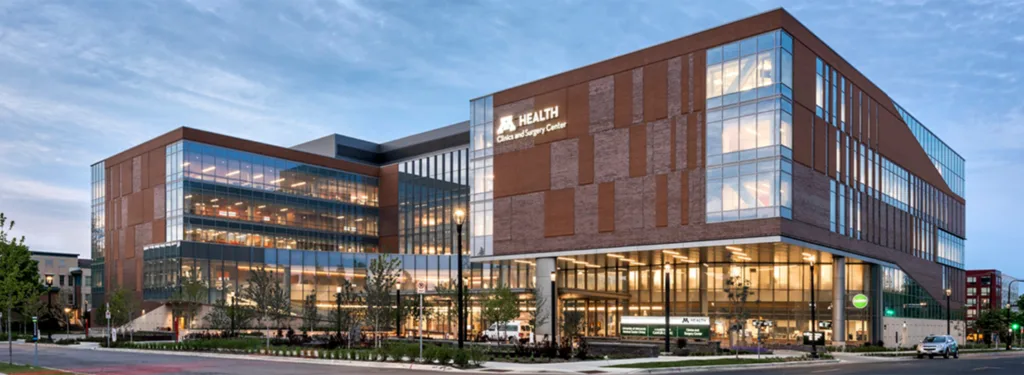
Key Clinical Sites & Health System Partners
The Department of Orthopedic Surgery benefits from collaborations with a network of distinguished clinical partners that enhance its ability to provide exceptional care, conduct groundbreaking research, and train future leaders. These partnerships include:
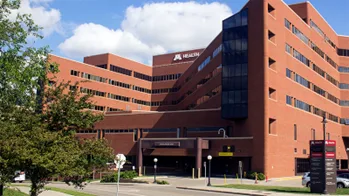
University of Minnesota Medical Center (UMMC) / M Health Fairview
M Health Fairview University of Minnesota Medical Center (UMMC) serves as the flagship hospital for the University of Minnesota’s Department of Orthopedic Surgery and its residency program. Recognized among the top 50 hospitals nationwide in adult orthopedics by U.S. News & World Report, UMMC offers residents exposure to a diverse patient population and a wide range of orthopedic conditions. The medical center’s commitment to excellence is further exemplified by its designation as a Blue Distinction Center+ for Knee and Hip Surgery and Spine Surgery, highlighting its expertise and efficiency in delivering specialty care.
M Health Fairview Clinics & Surgery Center (CSC)
The M Health Fairview Clinics and Surgery Center (CSC) in Minneapolis is a cornerstone of the University of Minnesota’s orthopedic care and training programs. Designed to improve patient experience across multiple specialties, the CSC sees over 13,000 cases annually, making it a high-volume hub for advanced surgical procedures. Recognized by Newsweek Magazine as one of America’s Best Ambulatory Surgery Centers in 2023, the CSC reflects the University’s commitment to excellence in outpatient surgical care. For the incoming Chair of Orthopedic Surgery, the CSC represents a key facility for delivering innovative care, advancing clinical research, and providing exceptional training opportunities for the next generation of orthopedic surgeons.
HealthPartners, headquartered in Bloomington, Minnesota, is the largest consumer-governed nonprofit health care organization in the United States. Founded in 1957 as a cooperative, it has supported health and well-being for over 65 years. HealthPartners provides integrated health care services and health plan financing and administration, serving more than 1.8 million medical and dental health plan members across Minnesota, Wisconsin, Iowa, North Dakota, and South Dakota. Its care system includes over 90 clinics and hospitals, 1,800 physicians, and 55 medical and surgical specialties, collectively serving more than 1.2 million patients annually.
The organization is a recognized leader in education and research, conducting over 400 research studies each year and training more than 700 medical residents, fellows, and 1,200 health professional students annually. Key facilities include Regions Hospital, a teaching hospital in St. Paul affiliated with the University of Minnesota, and TRIA Orthopedic Center, a collaborative partnership that advances orthopedic care, research, and education. HealthPartners’ nonprofit mission emphasizes community engagement, focusing on health equity, mental health, wellness, and prevention, making it a vital partner in academic and clinical excellence.

TRIA Orthopedic Center, established in 2005, is a premier provider of comprehensive orthopedic care and sports medicine in the Twin Cities area. As part of HealthPartners and Park Nicollet Health Services, TRIA offers a full spectrum of services, including orthopedic urgent care, physical therapy, and same-day surgeries in its state-of-the-art Ambulatory Surgery Center. The center is renowned for its innovative approaches, such as introducing Minnesota’s first walk-in orthopedic urgent care and expanding outpatient orthopedic surgeries.
TRIA’s commitment to excellence has made it the orthopedic provider of choice for professional athletes, including teams like the Minnesota Wild and Twins, as well as for patients of all activity levels.
In collaboration with the University of Minnesota’s Department of Orthopedic Surgery, TRIA serves as a vital site for clinical research and education. Many TRIA physicians hold faculty positions at the University, contributing to a robust educational environment for medical students, residents, and fellows. This partnership enhances TRIA’s mission to provide exceptional patient care while advancing orthopedic knowledge and training the next generation of orthopedic surgeons.
TRIA represents a key clinical site and collaborative partner for the UMN Department of Orthopedic Surgery, offering opportunities to engage in cutting-edge research, education, and clinical practice within a leading orthopedic institution.
Regions Hospital in St. Paul, Minnesota, is a nationally recognized leader in orthopedic trauma care and a vital partner in the University of Minnesota’s academic mission. As a Level I Adult and Pediatric Trauma Center, Regions Hospital provides comprehensive care for some of the most complex orthopedic injuries, including pelvic and acetabular fractures, chest wall trauma, and severe limb deformities. Its orthopedic trauma specialists are renowned nationwide for exceptional patient outcomes, pioneering surgical techniques, and an innovative approach to geriatric fracture care, earning the hospital certification as one of only five Premier Geriatric Fracture Care Programs in the country. Regions serves thousands of patients annually, including referrals from across the Upper Midwest, demonstrating its role as a critical referral center for orthopedic trauma.
The hospital’s partnership with the University of Minnesota and University of Minnesota Physicians (UMP) enhances its academic and clinical impact. It is a key training site for medical students, residents, and fellows, offering exposure to advanced surgical techniques and complex trauma cases. Notably, the partnership includes programs like the Combined Adult Reconstruction/Trauma Fellowship and the Regions Orthopedic Trauma Fellowship, equipping the next generation of orthopedic surgeons with specialized expertise. This collaboration ensures that Regions Hospital remains at the forefront of orthopedic trauma care while advancing education, research, and innovation in the field. Regions represents a critical clinical site and a platform for impactful leadership in patient care, education, and research for the UMN Department of Orthopedic Surgery.
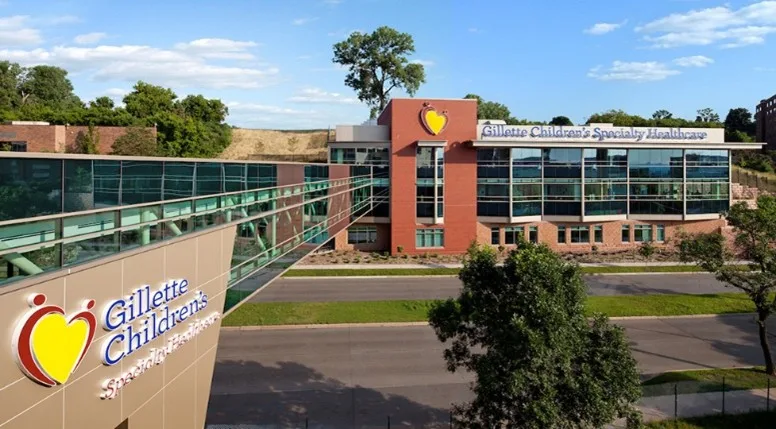
Gillette Children’s Specialty Healthcare
Based in St. Paul with multiple clinics in the metro area, Gillette Children’s Specialty Healthcare offers both inpatient and outpatient care to serve the needs of children with complex conditions, rare conditions, or traumatic injuries. Residents have an opportunity to work on the acute rehabilitation unit, in outpatient clinics serving the pediatric populations and in the Lifetime Clinics, serving adults with pediatric onset disorders. A unique feature of this site is their acclaimed gait and motion analysis lab which was developed over 30 years ago to help a multidisciplinary team treat cerebral palsy and its effects on gait.
CentraCare M Physicians (St. Cloud)
CentraCare, in collaboration with University of Minnesota Physicians (M Physicians), provides specialized bone and joint care throughout Central Minnesota. The team of fellowship-trained orthopedic surgeons offers expertise in sports medicine, joint replacement, trauma care, and foot and ankle conditions. With clinical services conveniently located in St. Cloud, Monticello, and Paynesville, patients can access advanced care close to home, minimizing travel and focusing on recovery and an active lifestyle.
CentraCare – St. Cloud Hospital, a 489-bed regional referral center and Level II trauma facility, serves as the hub of this outstanding care. With Magnet-designated nursing staff since 2004 and a full spectrum of inpatient and outpatient services, the hospital supports a wide range of medical and surgical specialties. As one of Minnesota’s largest health systems, CentraCare is committed to excellence in patient care, innovation, and community engagement, making it an ideal setting for advancing orthopedic surgery.
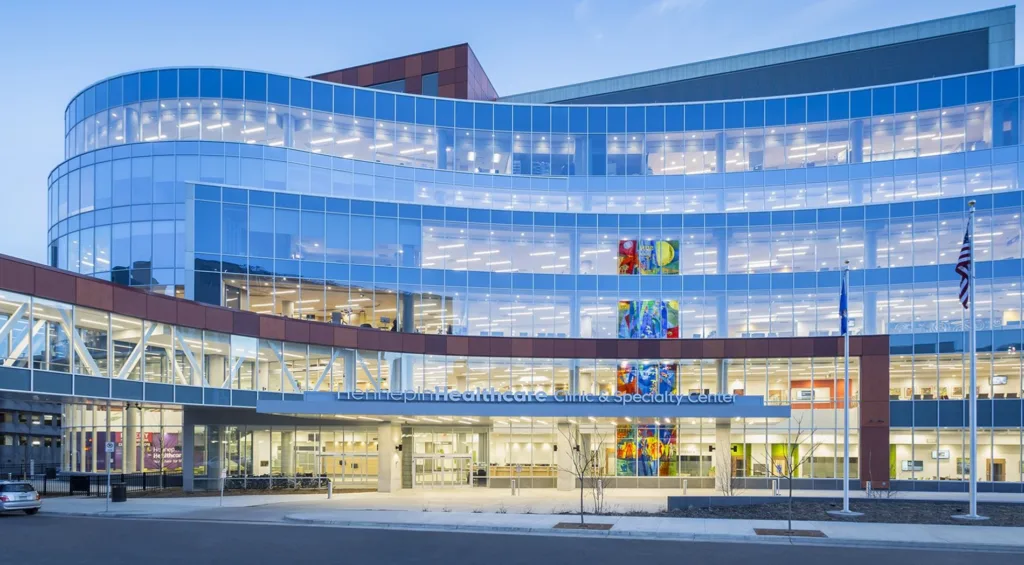
Hennepin County Medical Center
Hennepin Healthcare is an integrated system of care that includes a nationally recognized Level I Adult and Pediatric Trauma Center, an acute care hospital, as well as a clinic system with primary care clinics located in Minneapolis and across Hennepin County. The healthcare system includes a 484-bed academic medical center, a large outpatient Clinic & Specialty Center, and a network of clinics downtown, in the North Loop, Whittier, East Lake Street neighborhoods of Minneapolis, and in suburban communities of Brooklyn Park, Golden Valley, Richfield, and St. Anthony Village. Hennepin Healthcare has a large psychiatric program, home care, and operates a research institute and philanthropic foundation. Hennepin Healthcare includes Emergency Medical Services, which operates a large fleet of ambulances serving 14 cities in Hennepin County. The system is operated by Hennepin Healthcare System, Inc., a subsidiary corporation of Hennepin County.
The Minneapolis VA Medical Center provides comprehensive primary care and specialty health services, including surgery, psychiatry, neurology, oncology, and dentistry. Dedicated to serving veterans, the facility combines state-of-the-art technology with a multidisciplinary approach to deliver innovative, patient-centered care. As a teaching hospital affiliated with the University of Minnesota Medical School, the center plays a critical role in training healthcare professionals and advancing medical research. Located in the Twin Cities, the Minneapolis VA remains steadfast in its mission to honor and care for the nation’s veterans through excellence in healthcare.
Shriners Children’s Twin Cities provides expert surgical and nonsurgical treatment for a wide range of pediatric orthopedic conditions, emphasizing innovative techniques and personalized care plans for each child. The hospital offers comprehensive pediatric spine and spinal cord care, from non-surgical serial casting for infantile scoliosis to advanced tendon and nerve transfer procedures for children with spinal cord injuries. Additional services include low-dose radiology, motion analysis, bracing, casting, physical and occupational therapy, and prosthetic and orthotic care, all tailored to meet each patient’s unique needs. Families appreciate the convenience of receiving integrated care in one location, with a collaborative approach that ensures continuity and supports optimal outcomes for every .
Unique Centers of Excellence & Strategic Partnerships
Clinical and Translational Science Institute (CTSI)
The Clinical and Translational Science Institute (CTSI) at the University of Minnesota is transforming the way research is conducted to drive meaningful improvements in patient care. As part of the prestigious National Institutes of Health (NIH) Clinical and Translational Science Award (CTSA) program, CTSI is one of more than 50 hubs nationwide dedicated to accelerating the translation of scientific discoveries into real-world medical advancements. Through innovative research support, collaboration, and infrastructure, CTSI helps investigators and healthcare teams tackle system-wide challenges, ensuring that cutting-edge interventions reach patients and populations faster.
The University of Minnesota’s Stem Cell Institute is a global leader in stem cell research and regenerative medicine, pioneering breakthroughs that are transforming the treatment of musculoskeletal disorders. With a focus on innovation, the institute collaborates closely with the Department of Orthopedic Surgery on projects aimed at developing cutting-edge therapies to repair cartilage, regenerate bone, and treat complex orthopedic conditions.
As an NCI-designated Comprehensive Cancer Center, the Masonic Cancer Center is at the forefront of cancer research, offering robust opportunities for interdisciplinary collaboration. Its partnership with the Department of Orthopedic Surgery enables advancements in musculoskeletal oncology, including novel therapies for bone and soft tissue sarcomas and integrated patient care through multidisciplinary tumor boards.
The College of Veterinary Medicine
The College of Veterinary Medicine provides a unique platform for comparative orthopedic research, utilizing animal models to explore treatments for musculoskeletal diseases. Collaborative efforts between the college and the Department of Orthopedic Surgery drive innovations in translational research, benefiting both human and veterinary patients.
Center for Magnetic Resonance Research (CMRR)
The CMRR is a world-renowned facility dedicated to advancing imaging technology, including ultrahigh field MRI. Its partnership with the Department of Orthopedic Surgery enhances the understanding of musculoskeletal conditions through cutting-edge imaging techniques, aiding in diagnostics, treatment planning, and research.
College of Science & Engineering (CSE) Department of Biomedical Engineering
The CSE Department of Biomedical Engineering collaborates with the Department of Orthopedic Surgery on groundbreaking projects that integrate engineering principles with musculoskeletal health. Research efforts focus on developing advanced prosthetics, implants, and tissue engineering solutions to improve patient outcomes.
CSE Department of Mechanical Engineering
The CSE Department of Mechanical Engineering contributes to advancements in orthopedic biomechanics through innovative research in materials science and motion analysis. Collaborative projects include designing next-generation surgical tools and improving the durability of orthopedic implants.
Institute for Engineering in Medicine (IEM)
The IEM fosters interdisciplinary collaboration between engineering and medicine, making it a vital partner for the Department of Orthopedic Surgery. Joint initiatives include the development of wearable technologies, robotic-assisted surgical devices, and personalized treatment solutions for orthopedic patients.
Earl E. Bakken Medical Devices Center (BMDC)
The Bakken Center is a hub for medical device innovation, offering the Department of Orthopedic Surgery access to resources for designing and testing new technologies. Partnerships focus on advancing orthopedic surgical devices, rehabilitation tools, and imaging systems, ensuring state-of-the-art patient care. The BMDC is an interdisciplinary program within the Institute for Engineering in Medicine (IEM), focusing on the creation of technology-based solutions to solve clinical problems and training the next generation of medical device innovation leaders.
The Rehabilitation Sciences program works in tandem with the Department of Orthopedic Surgery to enhance post-surgical recovery and improve functional outcomes. Areas of collaboration include physical therapy research, biomechanics, and assistive device development for musculoskeletal patients.
UMN Sports Medicine provides elite care for athletes, from recreational participants to professionals, including the Minnesota Vikings and Twins. The program’s collaboration with the Department of Orthopedic Surgery emphasizes advancements in injury prevention, treatment, and rehabilitation for sports-related conditions.
TRIA Orthopedic Research Center
TRIA Orthopedic Center is a nationally recognized leader in orthopedic care, offering comprehensive services, including urgent care, surgery, and rehabilitation. As a partner of the Department of Orthopedic Surgery, TRIA provides unparalleled opportunities for research, training, and clinical collaboration. The TRIA Orthopedic Research Center plays a pivotal role in advancing musculoskeletal health, conducting innovative studies in areas such as injury prevention, joint preservation, and post-surgical recovery. This partnership fosters groundbreaking research and state-of-the-art training programs in sports medicine, trauma, and orthopedic innovations, ensuring the highest quality of care for patients across the spectrum of orthopedic needs.
The UMN Supercomputing Institute empowers orthopedic research with unparalleled computational resources. Through advanced modeling and data analysis, the institute supports studies on joint mechanics, implant design, and predictive analytics for musculoskeletal health.
Orthopedic Biomechanics Laboratory
The Orthopedic Biomechanics Laboratory conducts cutting-edge research on the mechanics of joints, bones, and soft tissues. Collaborating closely with the Department of Orthopedic Surgery, the lab develops novel surgical techniques, implants, and therapeutic interventions.
Musculoskeletal Research Training Program
This NIH-funded program trains future leaders in musculoskeletal research, offering access to state-of-the-art facilities and mentorship from leading scientists. It fosters collaboration between trainees and the Department of Orthopedic Surgery, advancing knowledge and innovation in the field.
Gillette Children’s Center for Gait Motion and Analysis
The Gillette Children’s Center is a world-class facility specializing in motion analysis and gait disorders in pediatric patients. Its partnership with the Department of Orthopedic Surgery enhances care for children with complex musculoskeletal conditions, utilizing advanced technology to improve outcomes.
Institute for Regenerative Medicine
This institute focuses on developing innovative regenerative therapies to repair and restore damaged tissues, including cartilage and bone. Collaborations between the Institute and the Department of Orthopedic Surgery offer opportunities to pioneer treatments for musculoskeletal conditions, such as arthritis, fractures, and degenerative joint diseases.
The Wearable Technology Lab specializes in designing advanced wearable devices for health monitoring and rehabilitation. Collaborative efforts with the Department of Orthopedic Surgery include developing wearable solutions to track patient recovery, improve mobility, and prevent injuries, particularly for athletes and post-surgical patients.
University of Minnesota Physical Activity and Movement Research Laboratory (PAMRL)
PAMRL is dedicated to understanding human movement and developing interventions to enhance mobility and reduce injury risks. Its partnership with the Department of Orthopedic Surgery supports research into motion analysis, biomechanics, and performance optimization.
Center for Aging Science and Care Innovation (CASCI)
This center focuses on the health and mobility of aging populations. Collaborations with the Department of Orthopedic Surgery include research on improving joint health, managing degenerative musculoskeletal conditions, and enhancing surgical outcomes in elderly patients.
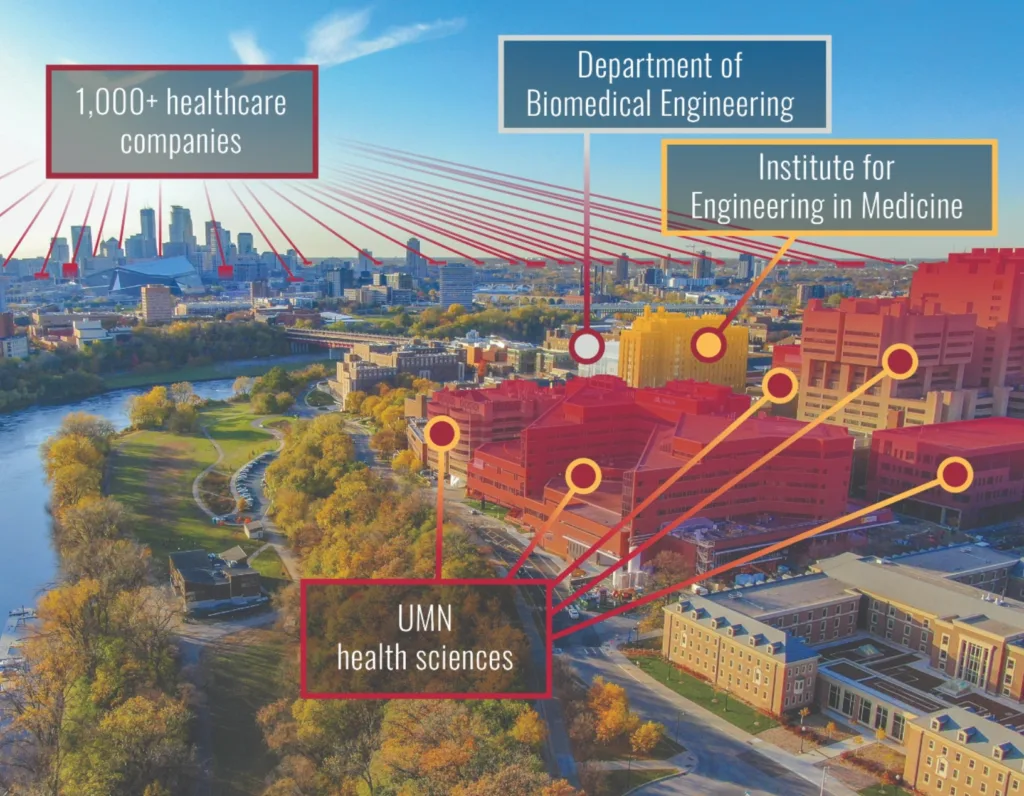
Medical Alley: A Hub for Industry Collaboration & Innovation
The University of Minnesota is in the heart of one of the world’s largest medical device clusters and an emerging biotechnology sector. The Department of Orthopedic Surgery benefits from its strategic location within Medical Alley, recognized as the Global Epicenter of Health Innovation and Care™. This renowned network comprises over 800 healthcare organizations, ranging from Fortune 100 companies to innovative startups, fostering a dynamic environment for collaboration and advancement in healthcare.
Medical Alley’s comprehensive ecosystem includes leaders in medical device manufacturing, biopharmaceuticals, diagnostics, and digital health, providing a fertile ground for interdisciplinary partnerships. The association’s initiatives, such as Medical Alley Starts, serve as venture platforms that accelerate the formation and growth of healthcare startups, offering resources and support to innovators in the field.
By engaging with Medical Alley’s extensive network, the Department of Orthopedic Surgery can leverage opportunities for research collaborations, access to cutting-edge technologies, and partnerships with industry leaders, thereby enhancing its capacity to deliver innovative orthopedic care and advance musculoskeletal health.
Translational Center for Resuscitative Trauma Care (TCRTC)
Established in 2022, the TCRTC focuses on developing and evaluating innovative acute trauma care solutions from the point of injury through early post-injury recovery. The Center’s research targets austere, low-resource, rural, and emergency care settings. By fostering a multidisciplinary, translational research environment, the TCRTC integrates trauma and emergency care research across Minnesota and supports the development of faculty and trainee research careers.
The translational research conducted at TCRTC aims to generate technology and knowledge products that can be utilized by first responders and hospital-based healthcare workers in both military and non-military.
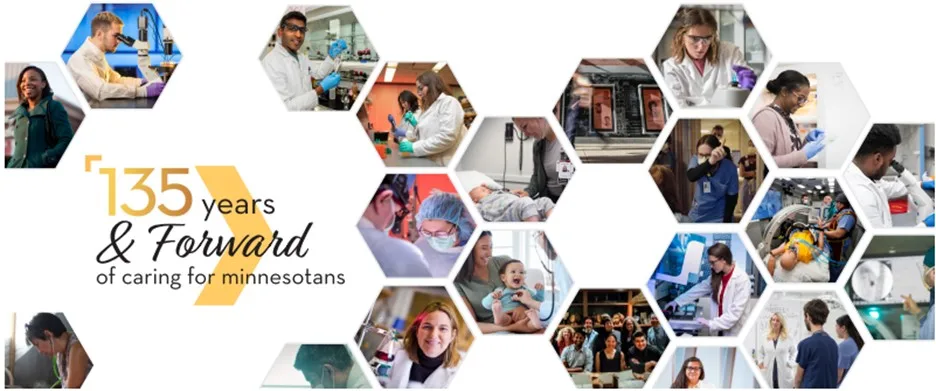
University of Minnesota
The University of Minnesota, founded in 1851, is one of the most comprehensive and prestigious public research universities in the United States. With its flagship Twin Cities campus boasting over 50,000 students, it ranks as the sixth-largest campus student body in the nation. The university offers an impressive array of academic programs, including more than 150 bachelor’s degrees, 200 master’s degrees, and 100 doctoral degrees across 19 colleges and schools.
As a leader in research and innovation, the University of Minnesota is consistently recognized for its significant research funding and impact. It is one of the top five most-funded public universities in the U.S., demonstrating its commitment to scientific advancement and groundbreaking discoveries. In Fiscal Year 2023, the University reported $1.32 billion in research and development expenditures on the Twin Cities campus, marking a 10% increase from the previous year and maintaining its position as one of the top ranked U.S. public research universities.
The Twin Cities campus offers an exceptional environment for both professional growth and quality of life. Minneapolis-St. Paul is home to 18 Fortune 500 companies, providing ample opportunities for collaboration and innovation. The area has been recognized for its livability, ranking highly in various metrics including literacy, entrepreneurship, and health3. With a vibrant cultural scene featuring 130 art galleries, 35 museums, and all four major professional sports leagues, the Twin Cities offer a perfect balance of academic excellence and urban amenities.
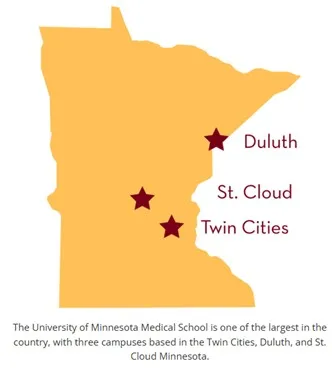
University of Minnesota Medical School
Founded in 1888, the University of Minnesota Medical School draws on over 135 years of improving medicine through education, scientific discovery, and giving patients innovative and compassionate care. The University of Minnesota Medical School is a world-class institution committed to innovation, diversity, and excellence in medical education, research, and patient care. The school offers:
- Cutting-edge research facilities and opportunities
- Collaborative, interdisciplinary environment
- Strong partnerships with leading healthcare systems
- Commitment to addressing health disparities and improving community heal
Academic Health
The Medical School is part of one of the premier academic health centers in the country. The University of Minnesota is the only school in the nation to have schools of medicine, dentistry, pharmacy, nursing, public health, and veterinary medicine all on one campus.
Nationally Recognized Research
Our medical school is revered as a national research powerhouse, with more than 10 research centers and institutes. We have long been recognized for its pioneering and are a worldwide leader in family medicine, regenerative medicine, transplantation, global medicine, and basic science research.
Facts & Figures

Operating across three campuses—Twin Cities, Duluth, and CentraCare Regional Campus in St. Cloud—it offers a comprehensive educational experience. The Medical School encompasses 27 departments and over 20 centers and institutes, supported by a faculty of more than 3,370 members, including 1,081 full-time, 971 affiliated, and 1,318 adjunct faculty.
The student body comprises approximately 932 MD students, 402 graduate students, and 56 MD/PhD students, with an additional 1,002 residents and fellows engaged in 150 programs across 21 specialties. In Fiscal Year 2023, the Medical School secured over $296 million in National Institutes of Health (NIH) sponsored research, ranking 24th nationally and 9th among public universities. This robust infrastructure and commitment to excellence position the University of Minnesota Medical School as a leader in advancing medical knowledge and healthcare delivery.
Our Dean
Jakub Tolar, MD, PhD is the Dean of the University of Minnesota Medical School and a Distinguished McKnight Professor in the Department of Pediatrics, Blood and Marrow Transplantation. He is also the Vice President of Clinical Affairs at the University of Minnesota, Board Chair for University of Minnesota Physicians and co-leader of M Health Fairview
Research
At the University of Minnesota Medical School, we’re leading the way to new treatments and methods of care.
Our research serves as an economic engine that drives Minnesota’s health industry. We develop new health technologies, and we collaborate with Minnesota’s biomedical companies to bring these technologies to clinics and hospitals worldwide.
We are finding better and faster ways to translate our laboratory research into clinical trials for patients—the only path to new treatments and cures.

Twin Cities: Minneapolis and St. Paul
The Twin Cities, comprising Minneapolis and St. Paul, offer a vibrant and dynamic environment that is both an economic powerhouse and a cultural hub. With a combined population of nearly 3 million, the metropolitan area is home to 19 Fortune 500 companies, including industry leaders such as 3M, Target, and UnitedHealth Group. This strong economic foundation is complemented by a highly educated workforce and one of the lowest unemployment rates among large metro areas in the country. The region is consistently recognized for its quality of life, with U.S. News & World Report ranking Minnesota as the fifth best state for opportunity, natural environment, infrastructure, economy, and health care.
Beyond its economic strengths, the Twin Cities boast an exceptional cultural scene that attracts creative professionals and families alike. The area is renowned for its diverse arts and music offerings, featuring numerous theaters, museums, and galleries. Outdoor enthusiasts will appreciate the extensive parks and trails system, which includes over 340 miles of interconnected trails and 52 regional parks that welcome more than 47 million visitors annually. The Twin Cities also offer a rich culinary landscape with award-winning restaurants and food trucks, making it a delightful place for food lovers. Whether enjoying professional sports or exploring local festivals, residents find ample opportunities for recreation and community engagement throughout the year.
- The population of the Twin Cities metropolitan area is currently over 3.2 million people.
- The Twin Cities offer an exceptional quality of life, combining urban amenities with natural beauty:
- Thriving economic center with 18 Fortune 500 companies
- Consistently ranked among the nation’s most livable cities
- Extensive parks, lakes, and trail systems
- Vibrant arts and culture scene, including world-class museums and theaters.
- Excellent public transportation, including light rail connecting downtown areas.
- Diverse and welcoming communities
- Four distinct seasons with year-round outdoor activities
Minneapolis proper contains the 5th highest concentration of Fortune 500 companies in the country. The presence of the corporate headquarters for companies such as Target, US Bancorp, Xcel Energy and Ameriprise Financial provide a growing economy with great job opportunities for a candidate’s spouse or family.
Additionally, an exciting arts and music scene, exceptional shopping, award-winning restaurants, wineries and craft breweries, and distinctive accommodations can be found throughout the area. Outdoor enthusiasts find plenty to do – even when temperatures dip, the variety of fun outdoor adventures does not. Sports fans cheer on their favorite team year-round. Big city bustle or small-town charm, anyone can find the activity that suits them in the Minneapolis-Saint Paul Area.
Minneapolis-Saint Paul is a metropolitan area in the heart of the Midwest, and the largest city in the state of Minnesota. It offers a high quality of life, excellent public schools, and a strong economy, consistently ranking as one of the best places to live in the United States. The area boasts a thriving arts and culture scene, with world-class museums, theaters, and music venues, as well as extensive park systems, lakes, and trails for outdoor enthusiasts.
Hub for Medical Innovation & Research
Minneapolis-Saint Paul is recognized as a hub for medical innovation and research, with numerous healthcare organizations, including the world-renowned University of Minnesota Medical School, located in the region. Despite its many amenities, the area has a relatively low cost of living compared to other major metropolitan areas in the United States.
The Twin Cities also have a rich history of diversity and inclusion, and the University of Minnesota is committed to fostering a welcoming and inclusive community. Additionally, Minneapolis-Saint Paul has a well-developed transportation system, including a light rail system, bus network, and extensive bike paths, making it easy to get around without a car. Overall, Minneapolis-Saint Paul offers a unique blend of urban sophistication, natural beauty, and cultural diversity that make it an attractive location for professionals in a variety of fields, including medicine and healthcare.
How to Apply
The University of Minnesota Medical School has retained the services of Academic Med, a leading executive search firm that specializes in Department Chair searches for Academic Medical Schools, to assist with this strategically important search. The search for this esteemed position is being conducted by Academic Med Principals, Gentry Zacheis & Jim Hagood. All inquiries, nominations, and applications will be handled with confidentiality.
Interested candidates should submit their curriculum vitae and a cover letter to:
- Jim Hagood, Managing Principal of Academic Med: jim@academic-med.com
- Gentry Zacheis, President & CEO of Academic Med: gentry@academic-med.com
Equal Opportunity Employer
The University of Minnesota is an equal opportunity educator and employer. All qualified applicants will receive consideration for employment without regard to race, color, creed, religion, national origin, sex, age, marital status, disability, public assistance status, veteran status, or sexual orientation.
Compensation & Benefits
This role is dually employed by the University of Minnesota and University of Minnesota Physicians. Salary for the Professor role at the University of Minnesota is dependent upon academic effort of the person hired, and begins at $55,000. Clinical salary, aligned with clinical effort, is provided through University of Minnesota Physicians. Total salary of academic effort, clinical effort and department head role is competitive with market and based on AAMC salary benchmarks. Total salary will be between $762,500 – $833,334. There is the potential for an annual bonus of up to 20%.
Application Process
The Search Committee, chaired by Dr. Samir Khariwala, will be accepting applications, nominations, and inquiries until 6:00 PM Eastern Time on Friday, April 4, 2025. To receive full consideration, all application materials must be submitted by this deadline.




